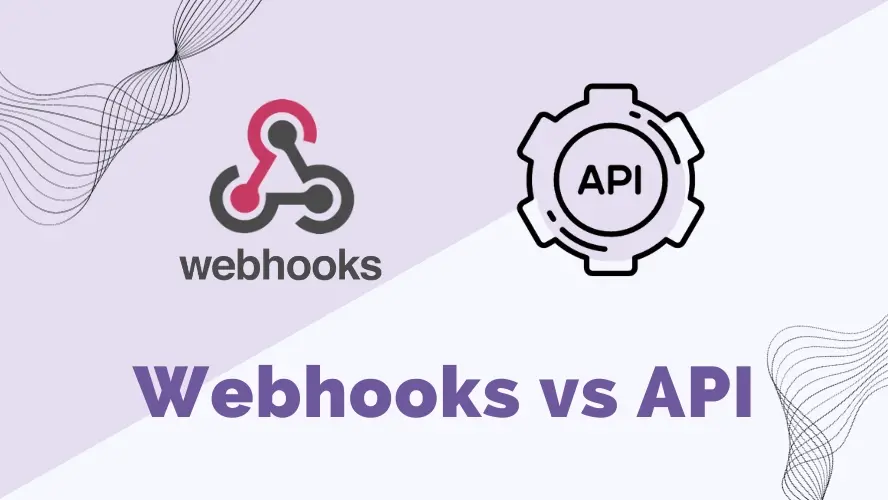Webhooks and APIs (Application Programming Interfaces) are both essential tools for enabling communication and data exchange between different software applications, but they serve distinct purposes and have different architectures. The choice between them depends on your specific use case and requirements, whether you need real-time event notifications, on-demand data retrieval, or a combination of both. Often, applications use a combination of webhooks and APIs to enable different types of interactions and communication patterns.
Introduction to Webhook and API
What is Webhook?
A webhook is a mechanism that allows one application or system to notify another application or system about specific events or updates in real-time. It enables seamless and immediate communication between different software components or services over the Internet.
Key characteristics and benefits of Webhook include:
Real-time
Webhooks enable real-time or near-real-time communication between applications, making them ideal for scenarios where immediate notification of events is crucial.
Efficiency
Webhooks eliminate the need for polling or constantly checking for updates. Instead, applications are notified only when relevant events occur, reducing unnecessary network traffic and server load.
Asynchronous
Webhooks facilitate asynchronous communication, allowing applications to remain decoupled and independently functioning.
Automation
They are commonly used for automating workflows and integrating different software systems or services.
Customization
Webhooks allow developers to define what events trigger notifications and how the target application should respond to them.
Scalability
They can be scaled to handle a large number of events and are suitable for various use cases, including e-commerce, IoT (Internet of Things), social media, and more.
What is API?
An API, or Application Programming Interface, is a set of rules and protocols that allows one software application or system to interact with and access the functionality or data of another software application, service, or platform. APIs serve as intermediaries that enable different software components to communicate and work together, even if they are developed independently or run on different platforms.
Key aspects and characteristics of API include:
Interface for Interaction
An API defines the methods, functions, and data structures that developers can use to interact with the underlying software or service. It acts as a contract that specifies how requests should be made and what responses can be expected.
Abstraction Layer
APIs provide a level of abstraction, shielding developers from the complexities of the underlying code or infrastructure. This abstraction simplifies the process of integrating and using external services.
Data Exchange
APIs enable the exchange of data between systems. This data can be in various formats, such as JSON, XML, or HTML, and can include information retrieval, modification, or the initiation of specific actions.
Standardization
APIs often adhere to established standards and protocols to ensure compatibility and consistency. For example, many web APIs use HTTP as the communication protocol and follow REST (Representational State Transfer) principles.
Authentication and Authorization
To ensure security, APIs often require authentication and authorization. This means that developers need appropriate credentials or tokens to access the API, and permissions are typically defined to control what actions can be performed.
Rate Limiting
To prevent abuse and ensure fair usage, APIs often impose rate limits on the number of requests a client can make within a specific time frame.
Monitoring and Analytics
API providers may offer tools for monitoring API usage, tracking performance, and gathering analytics to help developers and administrators understand how the API is being used.
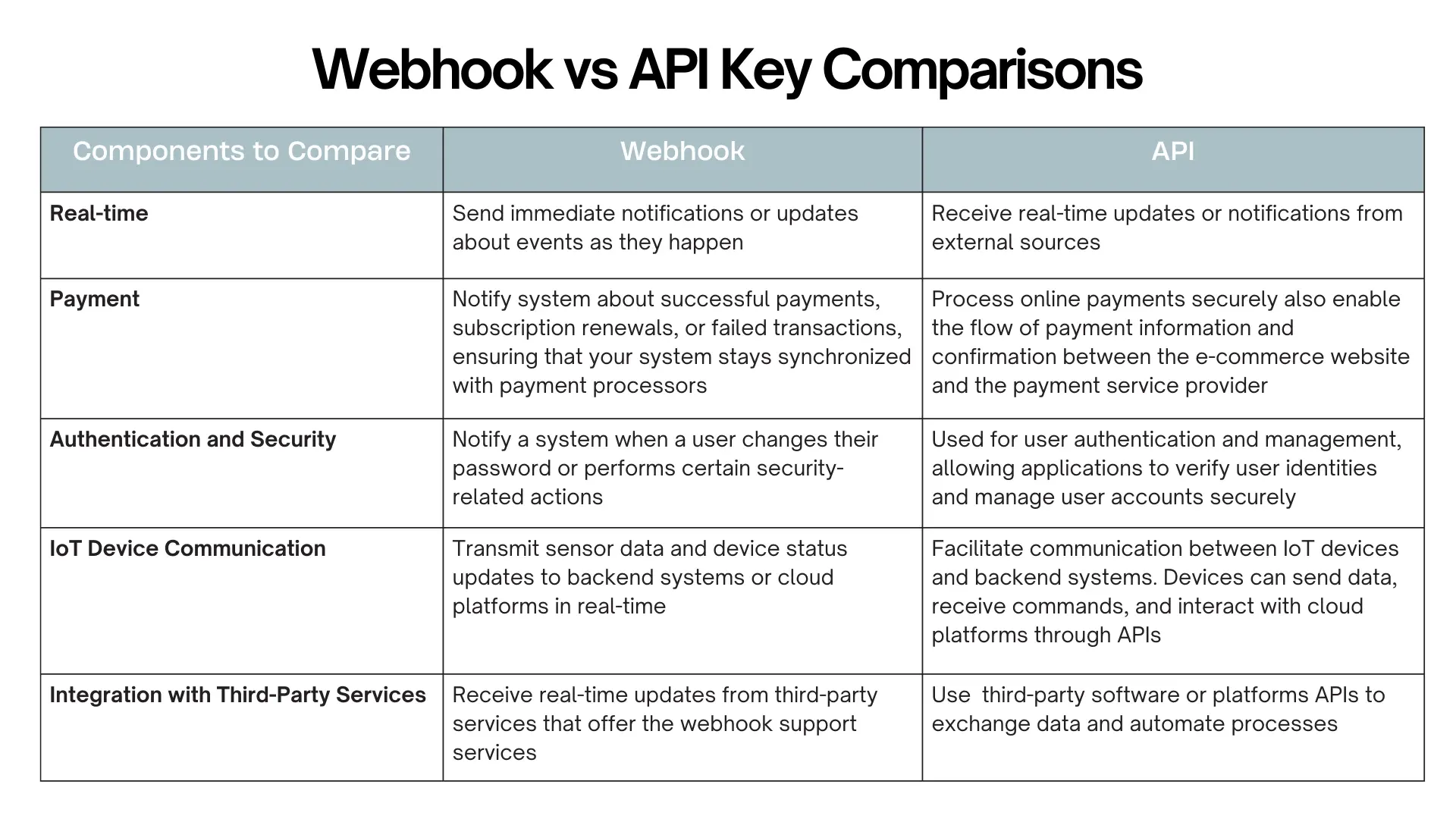
When to Use Webhook and API?
Webhook Best Uses
Webhooks are used in specific scenarios where you need real-time or near-real-time notifications about events or updates in another system or service. They are a push-based mechanism for event-driven communication. Here are some common situations when you should consider using webhooks:
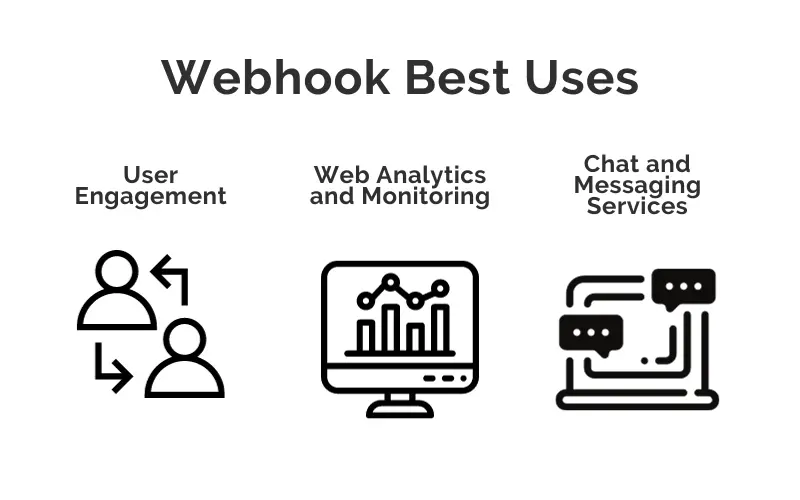
Real-time Notifications
When you require immediate notifications or updates about events as they happen. This is crucial for scenarios where timeliness is essential, such as instant messaging, live chat applications, or real-time monitoring of IoT devices.
Automation
Webhooks are useful for automating workflows and triggering actions in response to events. For example, you can use webhooks to automatically update your CRM system when a new lead is generated on your website.
User Engagement
In applications where user engagement is key, webhooks can be employed to send notifications to users in real-time. For instance, sending push notifications to mobile apps when new messages or updates are available.
Payment and Subscription Updates
In e-commerce and subscription-based services, webhooks can be used to notify your system about successful payments, subscription renewals, or failed transactions, ensuring that your system stays synchronized with payment processors.
Content Publishing
If you want to notify subscribers or other systems about new content, blog posts, or articles as soon as they are published, webhooks can be used to push this information to interested parties.
Authentication and Security
Webhooks can be employed for authentication and security purposes. For instance, they can be used to notify a system when a user changes their password or performs certain security-related actions, allowing for immediate responses.
IoT Device Communication
Webhooks are commonly used in IoT applications to transmit sensor data and device status updates to backend systems or cloud platforms in real-time, allowing for monitoring and analysis.
Web Analytics and Monitoring
For tracking user behavior and website performance, webhooks can be used to send data to analytics platforms immediately, providing real-time insights into user interactions.
Chat and Messaging Services
Webhooks play a significant role in chat applications and messaging services, ensuring that messages are delivered to recipients as they are sent and that participants receive notifications promptly.
Integration with Third-Party Services
When integrating your application with third-party services that offer webhook support, you can use webhooks to receive real-time updates from those services, enhancing the user experience and system functionality.
Data Synchronization
Webhooks can be used to keep data synchronized between systems. For example, you can use them to update your inventory system when products are sold on an e-commerce platform.
Event-Driven Architectures
Webhooks are a fundamental component of event-driven architectures, where various components or microservices communicate by sending and receiving events in real-time.
API Best Uses
APIs are used in various scenarios across software development to enable communication, data exchange, and integration between different systems or components. Here are some common situations when you should consider using an API:
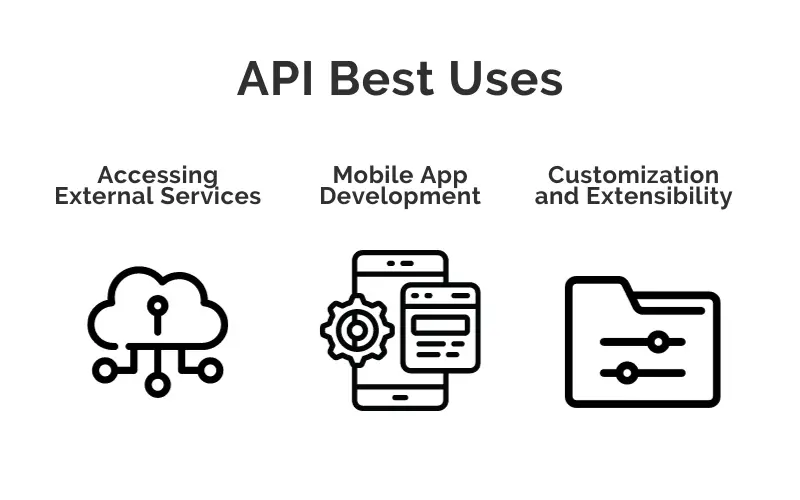
Accessing External Services
When your application needs to interact with external services, such as social media platforms (e.g., Facebook, Twitter), payment gateways (e.g., PayPal, Stripe), mapping services (e.g., Google Maps), weather data providers, or any other web-based service, you would use their APIs to retrieve data, send requests, or perform actions.
Integrating with Third-Party Applications
If you want to integrate your application with third-party software or platforms, like integrating your e-commerce website with a customer relationship management (CRM) system or an email marketing service, you would use their APIs to exchange data and automate processes.
Data Retrieval
When your application needs to fetch data from a remote server or database, an API allows you to make requests and retrieve specific data, whether it's weather information, stock prices, news articles, or any other type of data.
Data Sharing and Syndication
If you want to share your data or content with other applications or allow others to access your data, you can provide an API that allows authorized parties to access and consume your data programmatically.
Microservices and Distributed Systems
In microservices architectures and distributed systems, APIs play a crucial role in enabling communication between different microservices or components. Each microservice typically exposes an API that other microservices can use to interact with it.
Mobile App Development
APIs are commonly used in mobile app development to connect mobile applications with backend servers or cloud services. Mobile apps often need to fetch data from servers, send user-generated content, or perform various actions through APIs.
IoT (Internet of Things)
In IoT applications, APIs facilitate communication between IoT devices and backend systems. Devices can send data, receive commands, and interact with cloud platforms through APIs.
E-commerce and Online Payments
E-commerce platforms often integrate with payment gateway APIs to process online payments securely. These APIs enable the flow of payment information and confirmation between the e-commerce website and the payment service provider.
Content Management and Publishing
Content management systems (CMS) and publishing platforms often provide APIs to allow developers to create, update, and retrieve content programmatically. This is valuable for automating content workflows and publishing processes.
Customization and Extensibility
If you want to offer customization options or extensibility for your software, you can provide an API that allows developers to build plugins, extensions, or integrations with your application.
Authentication and User Management
APIs are used for user authentication and management, allowing applications to verify user identities and manage user accounts securely.
Real-time updates
When your application needs to receive real-time updates or notifications from external sources, such as social media updates, instant messages, or IoT sensor data, webhooks (which often involve APIs) can be used.
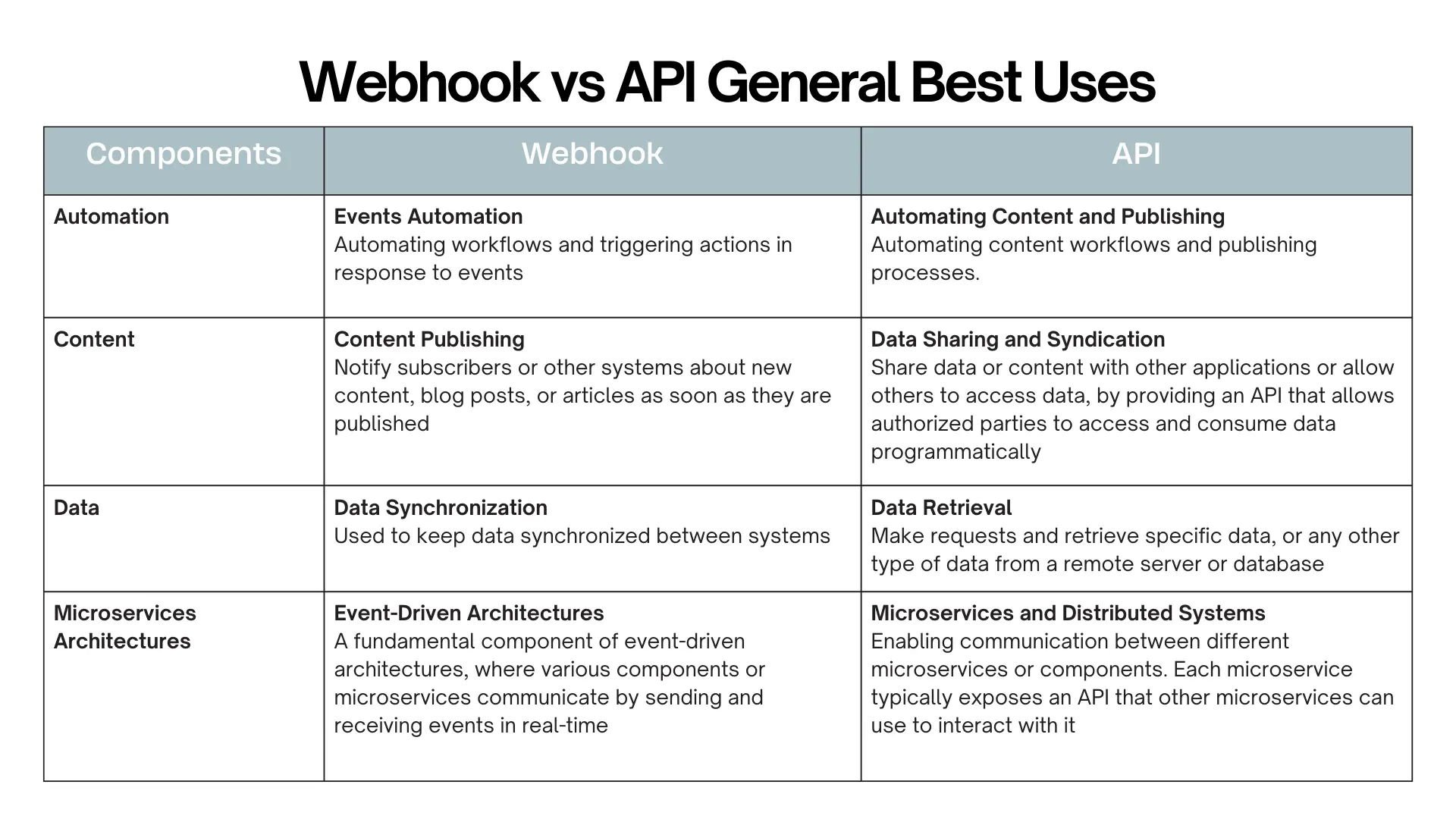
Conclusion
Webhooks are particularly valuable when you need to react to events or updates immediately, automate processes based on specific triggers, or ensure real-time communication and synchronization between different systems or services. They enable push-based communication, allowing your application to respond promptly to changes and events in other systems, ultimately enhancing user experience and efficiency.
APIs are versatile tools that can be used whenever you need to enable communication and data exchange between different software components, whether they are within your application or with external services and systems. APIs are a fundamental part of modern software development and integration, allowing for interoperability and the creation of powerful, interconnected software ecosystems.
Frequently Asked Questions
Can I easily integrate third-party tools and APIs with Verpex Web Development Hosting?
Yes, Verpex Web Development Hosting allows for easy integration of third-party tools and APIs, enabling you to streamline your workflow and enhance your project's functionality.
What is the difference between a database and a database management system?
A database is a collection of data that is stored in an organized manner while a database management system (DBMS) is software that allows users to create, access, and manage data in a database.
Does the data center location matter?
Sometimes. You Should try and find a host close to the geographic location your customer base is in. This should mean your site will load more quickly.
How do I choose a data host?
Find one that has everything your business needs. You’ll find a huge variation in features across suppliers, but always try and choose an option with servers located near your customers too.

Audee Mirza is a graphic designer and WordPress developer at audeemirza.com who resides in Surabaya, Indonesia. She's also the author of Graphic Identity Blog, a professional logo designer, and often creates vector illustrations for clients and marketplaces. She enjoys good typography design and all kinds of animation.
View all posts by Audee Mirza















